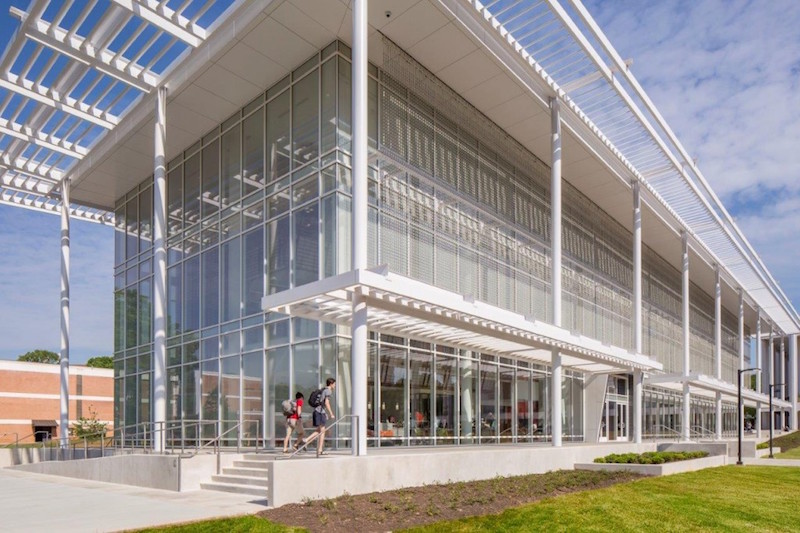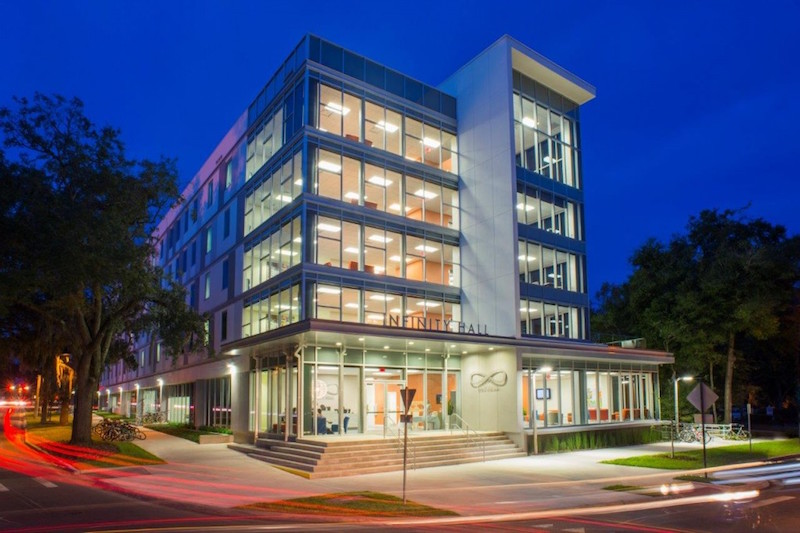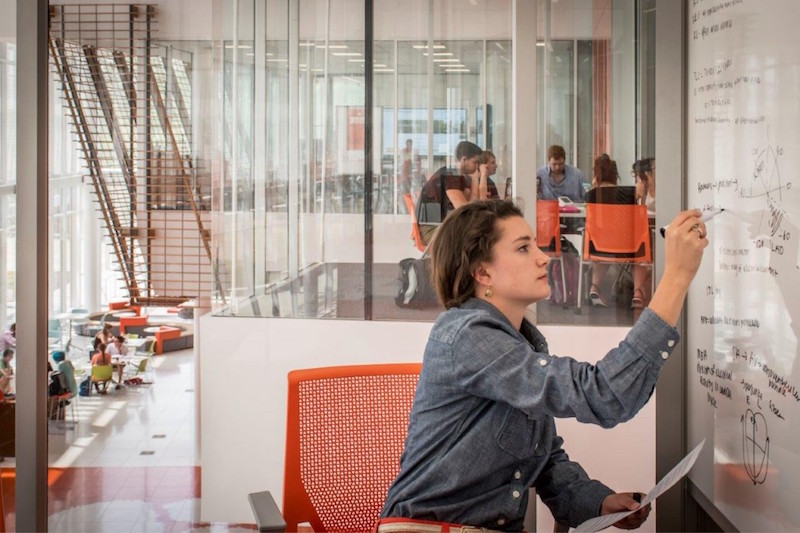The effort to remake higher education institutions into entrepreneurship and innovation hubs has escalated like a Cold War arms race. The promised payoffs of this innovation drive are institution-wide and community-deep: building relationships, aligning the institution, and preparing the organization as well as its students for transformational change. But how do you create space that can be messy and nonlinear in an institutional culture that is steeped in tradition, standards, and rules? It may be that pursuing effective university-driven innovation programs and facilities will involve equally innovative strategic approaches to design and development—for example, decoupling innovation centers from any single departmental steward and, perhaps, from institutional ownership overall.
Planning for places that foster effective innovation is still an emerging process, but the constant pressure on universities to do so continues from two of their key institutional constituencies—students and employers.
Generations Y and Z—and the expectations of their parents— are primarily sparking the innovation drive on campus. As the most digitally connected group in history, Generation Z students are preconditioned to massive disruption and uncertainty. Concerned that traditional career approaches cannot be trusted, they are highly motivated to build innovation skills and exercise their entrepreneurial interests— perhaps even more than their Generation Y predecessors.
The second group driving the growth of university innovation centers is the marketplace of corporate employers who recruit on campus. They require a workforce of more agile thinkers who can apply an owner’s mind-set and work ethic to ever-shifting market needs. More than ever, employers are evaluating job candidates on more than just grades— they want students who demonstrate leadership, critical thinking, and communication skills.
Colleges and universities are the natural connecting point for these trends. In the competition to demonstrate innovation mastery, university faculty and pedagogy need supporting infrastructure and technology. Campus design and architecture will be the prime catalysts for transforming universities into our society’s engines of growth.
BREAKING DOWN SILOS TO FOSTER INNOVATION AT CLEMSON UNIVERSITY
Clemson University’s Watt Family Innovation Center (WFIC) demonstrates the results of an intentionally nontraditional planning decision that has influenced the program’s success to date. The institution determined that no one college or department should “own” the center, which is—practically and symbolically—situated in neutral territory near the very center of the Clemson campus. The center’s independence frees it to bring together a diverse set of students to collaborate and innovate and to serve as a powerful cross-university resource.
 Courtesy of Perkins+Will
Courtesy of Perkins+Will
Clemson gave the design team behind the WFIC the imperative to foster “engaged learning” and showcase the university’s Creative Inquiry program. The program provides faculty, students, and the broader community a hands-on, interactive, engaged learning environment in which to collaborate on real-world projects ranging from aquaculture to bioengineering, digital media to industrial engineering. The WFIC also serves as a highly visible unifying force for the myriad innovation programs percolating at Clemson including the Clemson Innovation Network, the Design and Entrepreneurship Network, and the Arthur M. Spiro Institute for Entrepreneurial Leadership.
With the goal of elevating the impact and reputation of Clemson’s research, innovation, and creativity, the center’s oversized windows and ultra-modern open space provide a dynamic sense of transparency. Its easily movable furnishings, reconfigurable partitions, powered-over-Ethernet lighting, and high-speed virtual network connections provide the flexibility necessary to scale, pivot, and advance innovation. The WFIC is also configured with $12 million in advanced audio/ visual technology to allow students, faculty, and leaders from industry and government agencies to collaborate, generate big ideas, and solve complex problems.
 Courtesy of Perkins+Will
Courtesy of Perkins+Will
CREATING INNOVATIVE POSSIBILITIES THROUGH UNIQUE PARTNERSHIP AT THE UNIVERSITY OF FLORIDA
The University of Florida (UF) has taken a different approach to cultivating innovation and entrepreneurship for tomorrow’s students. It has taken on the role of city builder.
Nestled between the university campus and downtown Gainesville, UF’s Innovation Square is a 40-acre urban master plan for a modern live/work/play research and innovation community intended to link university research with commercial opportunity and lure smart, young talent to the campus and community.
The new Infinity Hall is billed as an “Entrepreneurial Living Learning Community,” a five-story, 97,000-square-foot combination dorm and new venture incubator for over 300 students. While Infinity Hall is open to all UF undergraduates, it is especially focused on housing Innovation Academy participants. Innovation Academy is a four-year undergraduate program in which students can combine any one of 30 majors with a minor curriculum emphasizing creativity, entrepreneurship, leadership, and innovation.
 Courtesy of Perkins+Will
Courtesy of Perkins+Will
The desire for housing that fostered innovation and entrepreneurship, in addition to serving as a source of funding, took the Infinity Hall project out of the traditional university planning process. Infinity Hall was conceived as a public-private partnership located off-campus in Innovation Square. This approach freed the facility from the constraints on entrepreneurial space usage that would have existed if UF went with standard state bond financing, direct ownership, and on-campus development.
Opening space on Infinity Hall’s first floor to allow nonresidents to provide relevant services was an important part of the project. The public-private partnership scenario made it easier for the Infinity Hall team to get the right kind of support needed to make this hybrid education-entrepreneurship, living-learning space succeed. While many of these components were developed internally, many others were realized with the help of commercial partners or other departments at the university.
Further, locating the facility within Innovation Square directly addressed a standard challenge for university planners: how to adequately address the “town and gown” issues involved in relating to the community, especially at the edges of campus. Infinity Hall serves as another level of bridge between UF and other parts of the Gainesville community.
DELIVERING ON PROMISED PAYOFFS
The significant number of students who are deeply engaged in their work in the space is the biggest proof of success for both the Clemson and University of Florida facilities. In its first full semester, the Watt Family Innovation Center is home to at least 60 different courses representing 29 academic departments across all of Clemson’s colleges. There are more than 3,000 Clemson students taking courses in the center and still more students using the small team rooms and collaboration areas in the hallways.
At the University of Florida, Infinity Hall has seen similar immediate success. Last August, for instance, two freshmen who met for the first time as residents of Infinity Hall launched Peru+You, a food product company representing Peruvian culture, beginning with their own brand of Canchita—a corn kernel product—that they now sell at local farmers’ markets as they pursue online and retail distribution.
With success stories like these, it is safe to say that tomorrow’s students are responding positively to the bets placed by major colleges and universities on innovation and entrepreneurship. Equally encouraging is how these institutions are thinking like entrepreneurs themselves: fully using all the resources at their disposal—including their physical and facility assets—and breaking free of prior planning paths to accomplish big goals and become engines for growth.
To read the full article, visit the Society for Campus and University Planning.
Related Stories
| Feb 13, 2014
University officials sound off on net zero energy buildings
As part of its ongoing ZNE buildings research project, Sasaki Associates, in collaboration with Buro Happold, surveyed some 500 campus designers and representatives on the top challenges and opportunities for achieving net-zero energy performance on university and college campuses.
| Feb 12, 2014
IIT's College of Architecture launches the Mies Crown Hall Americas Prize
Awarded biennially with a $50,000 prize, the program will recognize the most distinguished architectural works built on the North and South American continents in the preceding two years.
| Feb 4, 2014
World's fifth 'living building' certified at Smith College [slideshow]
The Bechtel Environmental Classroom utilizes solar power, composting toilets, and an energy recovery system, among other sustainable strategies, to meet the rigorous performance requirements of the Living Building Challenge.
| Feb 4, 2014
Must see: Student housing complex made with recycled shipping containers
Architect Christian Salvati's new structure is just the first step in bringing shipping container construction to New Haven, Conn.
| Jan 31, 2014
6 considerations for rehabbing student union buildings
Most colleges and universities feel pressure to offer the latest amenities in order to attract and retain the best and brightest students. While hauling in the bulldozer to create modern facilities is attractive in some regards, deciding to renovate can be just as effective and, in some cases, even preferable to new construction.
| Jan 29, 2014
Notre Dame to expand football stadium in largest project in school history
The $400 million Campus Crossroads Project will add more than 750,000 sf of academic, student life, and athletic space in three new buildings attached to the school's iconic football stadium.
| Jan 28, 2014
16 awe-inspiring interior designs from around the world [slideshow]
The International Interior Design Association released the winners of its 4th Annual Global Excellence Awards. Here's a recap of the winning projects.
| Jan 24, 2014
First look: Foster + Partners' new home for Yale School of Management [slideshow]
Edward P. Evans Hall, the new home of the Yale School of Management, has opened for business. The 242,000-sf facility was designed by Foster + Partners, with Gruzen Samton as architect of record.
| Jan 22, 2014
SOM-designed University Center uses 'sky quads,' stacked staircases to promote chance encounters
The New School's vertical campus in Manhattan houses multiple functions, including labs, design studios, a library, and student residences, in a 16-story building.
| Jan 13, 2014
Custom exterior fabricator A. Zahner unveils free façade design software for architects
The web-based tool uses the company's factory floor like "a massive rapid prototype machine,” allowing designers to manipulate designs on the fly based on cost and other factors, according to CEO/President Bill Zahner.

















